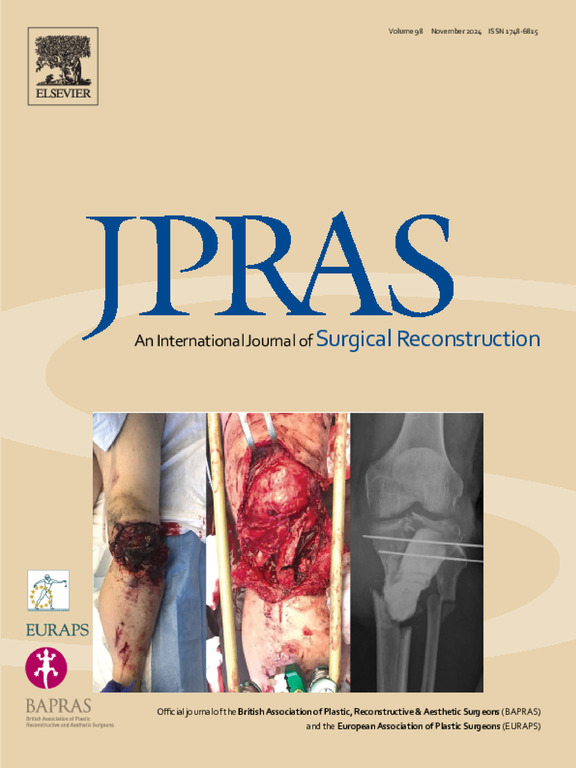背侧保留与背侧复位鼻成形术对美学和功能结果的影响:系统回顾和荟萃分析
IF 2
3区 医学
Q2 SURGERY
Journal of Plastic Reconstructive and Aesthetic Surgery
Pub Date : 2025-06-11
DOI:10.1016/j.bjps.2025.05.044
引用次数: 0
摘要
在鼻整形术中,背侧保留(DP)和背侧复位(DR)技术之间的结果差异尚不清楚。这项荟萃分析评估了DP和DR的功能和美学结果,修正手术,背侧不规则,残留和复发的驼峰。方法:我们检索PubMed、Cochrane和Embase,检索截至2025年1月20日的比较DP和dr的研究,主要结果是术后长期的标准化功能评分。次要结果是:短期标准化功能结果、主观美学结果(短期和长期)、长期标准化美学结果和总SCHNOS、需要的修复手术、背部不规则、残留和复发驼峰。采用亚组分析评价不同量表(SCHNOS、NOSE、VAS和UQ)。结果纳入10项研究(1339例)。DP显示UQ亚组对短期主观美学结果的满意度显著更高(MD为1.13分[95% CI: 0.74-1.52];p & lt;0.001;I²= 0%),背部不规则性显著减少(RR 0.28 [95% CI: 0.10-0.78];P = 0.01;I²= 0%),残留驼峰率和复发驼峰率显著高于对照组(RR 2.94 [95% CI: 1.23-7.03];P = 0.02;I²= 0%),与DR组相比。在标准化功能结果、主观美学结果、标准化美学结果、总SCHNOS或翻修手术方面没有发现显著差异。结论dp与dr相比具有更高的短期审美满意度(UQ)、更少的背侧不规则性和更高的残留和复发驼峰风险,其他结果组间无显著差异。本文章由计算机程序翻译,如有差异,请以英文原文为准。
Dorsal preservation versus dorsal reduction rhinoplasty techniques for aesthetic and functional outcomes: a systematic review and meta-analysis
Background
The differences in outcomes between dorsal preservation (DP) and dorsal reduction (DR) techniques in rhinoplasty remain unclear. This meta-analysis evaluates the DP and DR in terms of functional and aesthetic outcomes, revisions surgeries, dorsal irregularities, and residual and recurrent hump.
Methods
We searched PubMed, Cochrane, and Embase up to January 20th, 2025, for studies comparing DP versus DR. Primary outcome was standardized functional scores in the long-term postoperative period. Secondary outcomes were: short-term standardized functional outcomes, subjective aesthetic outcomes (sort-term and long-term), long-term standardized aesthetic outcome and total SCHNOS, revisions surgeries needed, dorsal irregularities, and residual and recurrent hump. Subgroup analyses were performed to evaluate different scales (SCHNOS, NOSE, VAS and UQ).
Results
Ten studies (1339 patients) were included. DP showed a significantly higher satisfaction in the UQ subgroup for short-term subjective aesthetic outcome (MD 1.13 points [95% CI: 0.74–1.52]; p < 0.001; I² = 0%), a significant reduction in dorsal irregularities (RR 0.28 [95% CI: 0.10–0.78]; p = 0.01; I² = 0%), and a significantly higher rate of residual and recurrent hump (RR 2.94 [95% CI: 1.23–7.03]; p = 0.02; I² = 0%), compared to the DR group. No significant differences were found in standardized functional outcomes, subjective aesthetic outcomes, standardized aesthetic outcomes, total SCHNOS, or revision surgeries.
Conclusion
DP was associated with greater short-term aesthetic satisfaction (UQ), fewer dorsal irregularities, and a higher risk of residual and recurrent hump compared to DR. There were no significant differences between the groups in the other outcomes.
求助全文
通过发布文献求助,成功后即可免费获取论文全文。
去求助
来源期刊
CiteScore
3.10
自引率
11.10%
发文量
578
审稿时长
3.5 months
期刊介绍:
JPRAS An International Journal of Surgical Reconstruction is one of the world''s leading international journals, covering all the reconstructive and aesthetic aspects of plastic surgery.
The journal presents the latest surgical procedures with audit and outcome studies of new and established techniques in plastic surgery including: cleft lip and palate and other heads and neck surgery, hand surgery, lower limb trauma, burns, skin cancer, breast surgery and aesthetic surgery.

 求助内容:
求助内容: 应助结果提醒方式:
应助结果提醒方式:


